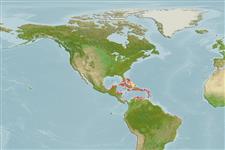Common names from other countries
Environment: milieu / climate zone / depth range / distribution range
Ecologia
; intervalo de profundidade 0 - 1 m (Ref. 83435). Tropical
Western Central Atlantic.
Length at first maturity / Tamanho / Peso / Idade
Maturity: Lm ? range ? - ? cm Max length : 10.0 cm TL macho/indeterminado; (Ref. 289)
Maximum depth from Ref. 110502. Epibiotic (Ref. 110502). Intertidal; very common on open shore (Ref. 289); common in the zone between tides in the rocky coast, mainly on rocks of arenaceous; adheres with great force to rocks (Ref. 292); intertidal, spray zones of rocky shores (Ref. 2022, page 122).
Life cycle and mating behavior
Maturidade | Reprodução | Desova | Ovos | Fecundidade | Larvas
Members of the class Polyplacophora are mostly gonochoric. Life cycle: Eggs hatch into lecitotrophic planktonic trocophore larvae (no veliger stage) which later metamorphose and settle on the bottom as young adults.
Burghardt, G. and L. Burghardt. 2006. (Ref. 281)
Status na Lista Vermelha da IUCN (Ref. 130435)
Status no CITES (Ref. 108899)
Not Evaluated
Not Evaluated
Uso pelos humanos
| FishSource |
Ferramentas
Mais informação
Idade/TamanhoCrescimentoComprimento-pesoComprimento-comprimentoMorfologiaLarvasAbundância
Fontes da internet
Estimates based on models
Preferred temperature
(Ref.
115969): 26.3 - 28.4, mean 27.3 (based on 199 cells).
Vulnerabilidade
Low vulnerability (10 of 100).
Categoria de preço
Unknown.
